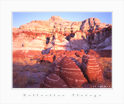
The Nation's boundaries are the Ute Mountain Ute Indian Reservation at the Four Corners Monument and stretch across the Colorado Plateau into Arizona, Utah, and New Mexico. Located within the Navajo Nation are Canyon de Chelly National Monument, Monument Valley, Rainbow Bridge National Monument, the Hopi Indian Reservation, and the Shiprock landmark. The seat of government is located at the census-designated city of Window Rock in Apache County, Arizona. There are several adjacent "Navajo Indian Reservations" (such as Alamocita) in this area, but generally function as sub-units of the "Big Rez" with considerable local autonomy). The Diné's traditional boundaries are the four sacred mountains, which actually include an area much larger than the present-day reservation.
 The
Navajo Nation was a very complex one. The eastern portion of the reservation,
located in New Mexico is popularly called the "Checkerboard" because
Navajo lands are mingled with fee lands (owned by both Navajo and non-Navajo
people) and federal and state lands under various jurisdictions. Large
non-contiguous sections of the Navajo Nation in New Mexico are: Ramah
Navajo Indian Reservation in western Cibola County and southern McKinley
County; Alamo Bend Navajo Indian Reservation in northwestern Socorro
County; and Canoncito Indian Reservation in western Bernalillo County
and eastern Cibola County. The total land area of the reservation is
62,362.062 km² (24,078.127 sq mi), making it by far the largest
Indian reservation in the United States. It is almost exactly the same
size as the state of West Virginia; it is slightly larger in land area,
but slightly smaller if water area is included. Its resident population
was 180,462 as of the 2000 census.
The
Navajo Nation was a very complex one. The eastern portion of the reservation,
located in New Mexico is popularly called the "Checkerboard" because
Navajo lands are mingled with fee lands (owned by both Navajo and non-Navajo
people) and federal and state lands under various jurisdictions. Large
non-contiguous sections of the Navajo Nation in New Mexico are: Ramah
Navajo Indian Reservation in western Cibola County and southern McKinley
County; Alamo Bend Navajo Indian Reservation in northwestern Socorro
County; and Canoncito Indian Reservation in western Bernalillo County
and eastern Cibola County. The total land area of the reservation is
62,362.062 km² (24,078.127 sq mi), making it by far the largest
Indian reservation in the United States. It is almost exactly the same
size as the state of West Virginia; it is slightly larger in land area,
but slightly smaller if water area is included. Its resident population
was 180,462 as of the 2000 census.
Other Amerind tribes are located in this area, including several Pueblo nations: Congress established a Hopi (Navajo, Oozéí, or Ayahkinii "underground-house-people") reservation within the Navajo Nation's reservation at an historic homeland where Hopi history predates that of Diné in the area. Adjacent or nearly adjacent to the Navajo Reservation are the Southern Ute of Colorado, the Ute Mountain Ute Tribe of Colorado, Utah, and New Mexico, both to the north; the Jicarilla Apache to the east, and other tribes to the west and south. A conflict over shared lands emerged in the 1980s, when the Department of the Interior attempted to relocate Diné living in the Navajo/Hopi Joint Use Area. The conflict was resolved, or at least forestalled, by the award of a seventy-five-year lease to Diné who refused to leave the former shared lands. (Source Wikipedia)
© 1998-2026 - C. Cassegrain Photograph - All rights reserved v.03 - Mobile : +33 6 71 26 04 76 |